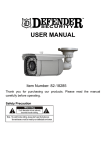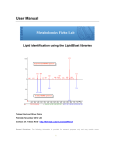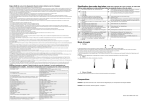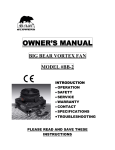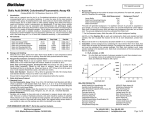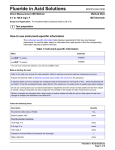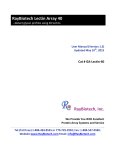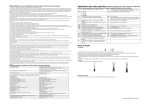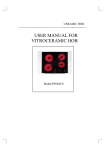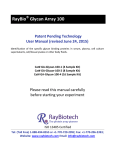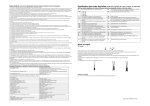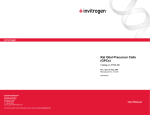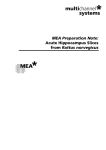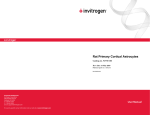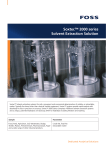Download Oligodendrocyte Progenitor Cell Starter Kit
Transcript
Neural Cell Solutions in CNS Research Oligodendrocyte Progenitor Cell Starter Kit User Manual Cat. No. OPC-SK Life could be that easy . . . NG2 glia / OPCs within two days! Check all kit components immediately upon arrival for completeness and storage conditions FOR RESEARCH USE ONLY. NOT FOR DIAGNOSTIC AND THERAPEUTIC USE. © May 2013, P.Glia P.Glia Website: www.pglia.com Email: [email protected] Table of Contents Kit Components and Storage 3 Additional Materials Required 4 Introduction 5 Principle and Benefits 6 Protocol: A. B. C. D. E. General considerations Tissue dissociation Isolation of single cell suspensions OPC propagation and isolation OPC expansion and further applications 10 10 11 12 12 Abbreviations BSM CDS‐1 CDS‐2 CDS‐3 CNS GalC MAD‐O MBP MDS MOG OGM OSDM OL OPC OPC‐exp PDGF‐AR PLP RT SDM basal support medium cell dissociation solution 1 cell dissociation solution 2 cell dissociation solution 3 central nervous system galactocerebroside multiple adhesion dish (for oligodendrocytes) myelin basic protein mild dissociation solution myelin oligodendrocyte glycoprotein oligodendrocyte growth medium oligodendrocyte survival & differentiation medium oligodendrocyte oligodendrocyte progenitor cell OPC expansion dish platelet‐derived growth factor‐alpha receptor proteolipid protein room temperature separation density medium 2 Kit Components and Storage Please examine all kit components immediately upon arrival for leakage or breakage. Notify P.Glia or your distributor immediately if any problems occur. Please note that if kit components thaw during shipment, their activity remains unaffected if they are stored at the adequate temperature (see Table 1: notes 1, 2) Except for Separation Density Medium which should be stored at 2‐8oC, all other kit components must be transferred immediately to a freezer and stored at ‐20oC until use. Once thawed, cell culture media must be stored at 2‐8oC as indicated in Table 1. Do not refreeze. Table 1. OPC Starter Kit components and storage conditions. Cat. No. Description Amount Storage / Stability CDS‐1 Cell dissociation solution 1 1 x 1 ml ‐20 C for 12 months o 1 o 1 o 1 o # o 2 o 2 o CDS‐2 Cell dissociation solution 2 1 x 1 ml ‐20 C for 12 months CDS‐3 Cell dissociation solution 3 1 x 100 µl ‐20 C for 12 months SDM Separation density medium 1 x 20 ml Note 2‐8 C for 12 months BSM Basal support medium 1 x 30 ml ‐20 C for 12 months o 2‐8 C for 1 month OGM Oligodendrocyte growth medium 1 x 20 ml ‐20 C for 12 months o 2‐8 C for 2 weeks MAD‐O Multiple adhesion dish (OL) 1 x 95 mm ∅ ‐20 C for 6 months 1 Manual OPC Isolation Kit 1 x manual 1 x check list 1 2 # o If thawed during shipment, freeze again at ‐20 C until use. No loss of activity! If thawed during shipment and not going to be used within one week, freeze again at o o ‐20 C in working aliquots until use. Always thaw overnight at 2‐8 C. Avoid repeated freezing and thawing which will impair the activity of culture media! o o Before storage at 2‐8 C, incubate at 37 C to redissolve all ingredients and obtain a clear solution. Always shake the bottle before use ! OPC‐SK is a basic starter kit for OPC isolation from early postnatal mouse or rat brain (for overview, see Table 2 on page 9). Additional P.Glia media & reagents needed would depend on your specific applications and can be purchased separately (see page 4 and page 12). 3 Additional Materials Required • • • • • • • • • HBSS (Hanks´ balanced salt solution), without calcium chloride and magnesium sulfate, sterile‐ filtered PBS, pH 7.4 (10 mM phosphate buffer pH 7.4, 140 mM NaCl, 3 mM KCl), sterile‐filtered sterile instruments for tissue preparation (fine scissors, tweezers, forceps) sterile tubes (15 and 50 ml) and culture dishes (60 mm ∅) sterile serological pipettes, 200 µl and 1 ml micropipettes and pipette tips sterile pasteur/fire‐polished pasteur pipettes (optional) cell strainer, 40 µm (optional) standard cell culture equipment: inverse microscope, centrifuge (optimally with a swing‐out rotor), laminar flow, humidified 37oC, 5% CO2 incubator Attention! Adjust speed (390 ± 1 x g) and time (5 min) of your lab centrifuge and keep these parameters throughout the whole isolation procedure. Additional P.Glia media and reagents which can be purchased separately if needed: Cat. No. Description Size Storage OGM * Oligodendrocyte growth medium is a serum‐free chemically defined medium specially formulated to support the growth of oligodendrocyte progenitor cells (OPCs) for 2‐3 weeks in vitro. 50 ml ‐20 C OGM‐exp * Oligodendrocyte growth medium‐exp is a serum‐free 50 ml chemically defined medium specially formulated to support the rapid expansion of OPCs in culture. ‐20 C P.Neural * P.Glia defined neural medium is a chemically defined medium formulated for culturing of different neuronal and glial cells/cell lines under serum‐free conditions. 50 ml ‐20 C OSDM * Oligodendrocyte survival and differentiation medium is a 30 ml unique serum‐free medium specially formulated to support the survival and terminal differentiation of brain‐derived OPCs into mature oligodendrocytes (OLs). ‐20 C MAD‐O Multiple adhesion dish (for oligodendrocytes): contains 4 x 95 mm multiple cell binding sites specially formulated for OPC isolation from mouse or rat brain cell suspensions (after 2 days of culture in OGM). ‐20 C PL‐D * Poly‐lysine containing dish: allows the rapid expansion of MAD‐derived OPCs within 2 days of culture in growth medium. PL containing dishes can also be used for culturing of other primary neural cells. 8 x 60 mm 2‐8 C MP‐D Microglia preadhesion dish: contains cell binding sites allowing 4 x 95 mm the rapid adhesion and removal of contaminating microglia from brain cell suspensions. ‐20 C * see also under „your specific applications“ on page 12 See also P.Glia website for related products and applications. 4 o o o o o o o Introduction In addition to neurons, the brain contains three main types of glial cells: astrocytes, oligodendrocytes and microglia. Glial cells significantly contribute to the health and disease state of the central nervous system (CNS) and a number of neurodegenerative disorders have been associated with glial cell dysfunction (1). The application of glial cell culture techniques for the analysis of their cellular and molecular properties has therefore become a promising tool in biological and medical sciences (2). Particularly for oligodendrocytes, rapid and reliable methods for the isolation and culture of high‐yield, pure and viable cell populations at distinct differentiation stages are yet missing. Oligodendrocytes are the myelin‐forming cells in the CNS whose main function is the insulation of axonal processes by the formation of the myelin sheath. During late embryonic and early postnatal development of the mammalian forebrain, oligodendrocytes arise in the subventricular zones of the lateral ventricles from oligodendrocyte progenitor cells (OPCs). OPCs migrate out from these germinal zones to populate the developing white and gray matter. There, cells become postmitotic and differentiate into mature oligodendrocytes of multipolar morphology (3, 4, 5). An overview on the molecular marker expression along the oligodendrocyte cell lineage is given in Figure 1. Figure 1. Molecular phenotype of oligodendrocyte (OL) lineage cells. Early (O‐2A) OPCs express gangliosides (GD3, A2B5), NG2 chondroitin sulfate proteoglycan, ß1 integrins (ß1 int) and PDGF‐alpha receptor subunit (PDGF‐AR). Late OPCs (pro‐OLs) express gangliosides, ß3 integrin (ß3 int) and O4 antigen/sulfatides and have lost NG2 and ß1 integrin expression. Further lineage progression of immature O4+ OLs is characterized by the sequential expression of myelin‐ specific glycolipids (sulfatides and GalC) and proteins (MOG, MBP, PLP) involved in their terminal differentiation into mature, myelin‐forming cells. References 1. 2. 3. 4. 5. Schmitz T, Chew LJ (2008) Cytokines and myelination in the central nervous system. ScientificWorld Journal 8: 1119‐ 1147. van Noort JM (2006) Human glial cell culture models of inflammation in the central nervous system. Drug Discovery Today 11: 74‐80. Miller RH (1996) Oligodendrocyte origins. Trends Neurosci. 19: 92‐96. Nave KA (2010) Oligodendrocytes and the "micro brake" of progenitor cell proliferation. Neuron 65: 577‐579. Richardson WD, Kessaris N, Pringle N (2006) Oligodendrocyte wars. Nat Rev Neurosci. 7: 11‐18. 5 Principle and Benefits The MAD (multiple adhesion dish) principle of neural cell isolation relies on basic knowledge in cell biology that the strength of cell adhesion to the surrounding matrix or to other cells strongly depends on the affinity of different cellular receptors to their extracellular ligands and the respective activation of intracellular signaling. Ligand‐receptor interactions may thus result into diverse adhesive forces varying from very stable to weak or even repellent. The unique properties of MAD‐O are based on accordingly selected multiple cell binding sites supporting the adhesion of different cell types and of different adhesive strength. Taking an advantage of such molecular mechanisms, the MAD‐O surface allows the isolation NG2 glia/OPCs out of a complex brain cell mixture due to the weak adhesiveness of target cells. Moreover, this takes place under defined culture conditions favoring the growth of the desired cell type (Figure 2). Figure 2. MAD principle or the power of being weak. The unique properties of MAD are based on multiple cell binding sites supporting the adhesion of different cell types and of different adhesive strength, from weak (of the target cells) to very strong. After 2 days in culture of brain cells in growth medium (OGM), weak cellular interactions with the MAD surface can be disrupted by agitation of the MAD‐O dish and cells collected by centrifugation. How it works For NG2 glia/OPC isolation, all you need to do is to dissociate early postnatal brain tissue and plate single cell suspensions into MAD‐O in a specialized oligodendrocyte growth medium (OGM or OGM‐pro). Then just let brain cells undisturbed for two days in culture. The concept of the MAD‐O surface is such that OPC interactions and adhesion are the weakest ones. Upon short agitation of the culture dish, OPCs can easily be detached from MAD and collected by centrifugation. The procedure allows an easy and reliable isolation of NG2 glia/oligodendrocyte progenitors. It has been optimized for early postnatal mouse or rat brain tissue. 6 The flow charts below (Figure 3) give a short cut of the bench protocol and further culturing options for MAD‐O‐derived NG2 glia/progenitor cells. Figure 3. Bench protocol (upper panel) and further OPC applications (lower panel). MAD‐derived OPCs can be further expanded in OGM or OGM‐exp (oligodendrocyte growth media) on PL dishes or directly differentiated into mature OLs for further 3‐6 days in OSDM (oligodendrocyte survival & differentiation medium). For further details, see OPC‐K Manual. Purity and cell yields. Since the control of OPC detachment from MAD under a microscope (by agitation) can be very individual‐dependent, the number and purity of isolated cells after two days may vary. 7 What you get The following Figure 4 shows MAD‐O‐derived cells you get (NG2 glia/oligodendrocyte progenitors) after culture in OGM (growth medium). Figure 4. MAD for oligodendrocyte progenitor cell isolation. P3 mouse forebrain‐derived cells were grown for 2 days on MAD‐O in Oligodendrocyte Growth Medium (OGM) and OPCs were collected from the dish by agitation. MAD‐derived OPCs were plated into PL (poly‐lysine containing) dishes and expanded in OGM for further 2 days. Three specialized oligodendrocyte media help to meet your particular needs: • Oligodendrocyte Growth Media (OGM, OGM‐exp, OGM‐pro) are specialized serum‐free media optimally supplemented with growth factors to support rapid OPC (NG2+ A2B5+ O4+) expansion. • Oligodendrocyte Survival & Differentiation Medium (OSDM) is a unique serum‐free medium containing neuronal factors and supporting both OL survival and differentiation into mature (MOG+ GalC+ MBP+ PLP+) myelin‐forming cells. The isolation procedure has been optimized for postnatal day 3 (P3) mouse brain tissue and also applies to P2 rat and P7‐8 mouse brains, respectively. In order to obtain higher cell yields and reduce myelin contamination, it is strongly recommended to exactly stick to the parameters (i.e. enzymatic treatment, density centrifugation parameters, number of culture dishes, etc.) worked out for the number and age of animals given in Table 2 on page 9. With P.Glia media and reagents you have, of course, no limits for your scientific creativity towards optimizing your personal needs of animals, brain age and region, etc. 8 Table 2. Number of postnatal animals and amounts of reagents required. Treatment / Reagent 2 x P3 mouse forebrains 2 x P2 rat forebrains 1 x P7 mouse forebrain CDS‐1 1 x 1 ml, 8 min, RT 1 x 1 ml, 8 min, RT 1 x 1 ml, 15 min, RT CDS‐2 1 x 1 ml, 5 min, RT 1 x 1 ml, 5 min, RT 1 x 1 ml, 5 min, RT CDS‐3 1 x 100 µl, 10‐15 min, RT 1 x 100 µl, 10‐15 min, RT 1 x 100 µl, 10‐15 min, RT SDM centrifugation 2 x 6.2 ml cushion 2 x 6.2 ml cushion 2 x 6.5 ml cushion MAD‐O culture 1 x 95 mm dish: 2 days 1 x 95 mm dish: 2 days 1 x 95 mm dish: 2 days PL dish culture (in OPC‐K) 1 x 60 mm dish: 2 days 2 x 60 mm dish: 2 days 1 x 60 mm dish: 2 days MP dish (not included) 1 x 95 mm dish: 30 min 1 x 95 mm dish: 30 min 1 x 95 mm dish: 30 min Cell strainer * (in OPC‐K) 1 x 40 µm 1 x 40 µm 1 x 40 µm MDS 5‐10 min, 37 C 5‐10 min, 37 C 5‐10 min, 37 C (1 x 8 ml in OPC‐K) (2 ml/60 mm PL dish) (2 ml/60 mm PL dish) (2 ml/60 mm PL dish) BSM 1 x 30 ml 1 x 30 ml 1 x 30 ml OGM (in OPC‐K & OPC‐SK) 1 x 30 ml 1 x 30 ml 1 x 30 ml OSDM (for mature OLs) 30 ml (not included) 30 ml (not included) 30 ml (not included) • • • o o o Perform these steps if you want to increase OPC number in growth medium (OGM or OGM‐pro) on PL dishes eliminate possible microglia contamination on MP dish obtain mature OLs in differentiation medium (OSDM) o * Without cell strainer: Alternatively, let undissociated tissue pieces settle down by gravity for 10 min at 4 C. Carefully transfer the single cell suspension into a new tube and centrifuge. Benefits at a glance: • • • • • • • • • cost‐effective and time‐saving (at least fourfold) animal‐saving (> 50%) easy handling (no longer than 2 hours work on the bench at Day 0) no dedicated equipment required high cell yields from postnatal brains (up to 1 x 106 cells within 4 days) the unique MAD properties: differential brain cell adhesion and target cell isolation > 90% pure OPC population within 2 days high OPC number due to the unique properties of OGM, OGM‐exp and OGM‐pro oligodendrocyte growth media oligodendrocyte survival and maturation due to the unique properties of OSDM Please note that in primary cell cultures, the final cell yields may vary dependent on animal species, number and age of animals used, between individual animals, operator´s skills and/or additional materials used. 9 Protocol PLEASE READ THIS PROTOCOL CAREFULLY BEFORE STARTING WITH CELL ISOLATION A. General considerations You should be aware of the following safety rules concerning aseptic handling of primary animal tissue and cell culture materials: 1. Decontaminate all surfaces of workbenches, microscope(s), laminar flow, etc. going to be used for tissue preparation and cell culture with 70% alcohol to ensure they are sterile. 2. Decontaminate external surfaces of all vials, bottles and micropipettes with 70% alcohol to ensure they are sterile. 3. Make sure all solutions, cell culture materials and instruments for tissue preparation are sterile. 4. Always thaw cell culture media overnight at 2‐8oC (see Table 1 for further details). 5. Perform cell culture work only in a sterile hood or laminar flow. 6. Do not pipette with mouth. 7. Always wear protective gloves and lab coat when working with primary animal tissue. 8. After thawing, always keep enzyme solutions on ice until use. The following protocol is recommended for OPC isolation using 2 forebrains from P3 mice or P2 rats. Amounts of solutions and incubation times indicated at different steps of this protocol have been optimized exactly for the number of postnatal animals used (see Table 2, page 9). Change of any parameters is not recommended and no responsibility will be taken accordingly. To facilitate the step‐by‐step performance avoiding unprepared handling, some preparatory steps (in italic bold) have also been included. The whole procedure takes about 1.5‐2 hours (from tissue preparation to culturing of brain cells). Attention! All P.Glia dishes should be washed 2 x 10 min with PBS before use. Before starting with cell isolation, place MAD(s) at RT and rehydrate for 10 min in PBS. Wash once with PBS and keep in Oligodendrocyte Growth Medium (6 ml/95 mm dish) in a humidified CO2 incubator until use. B. Tissue dissociation Day 0 1. Prepare one unpolished and one fire‐polished sterile pasteur pipettes (with an aperture of 0.5‐ 1 mm in diameter using a gasburner) and keep the pipettes in 15 ml sterile tubes until the end of the cell isolation procedure. Prepare one 50 ml sterile tube for waste. 2. Decapitate postnatal mice/rats and collect heads in a sterile dish. Decontaminate the entire surface of the skin with 70% alcohol and wait for 3‐5 min to ensure it is sterile. 3. In the meantime, prepare 2 x culture dishes (60 mm ∅ ) with HBSS (2 ml/dish). 4. Carefully remove the skin from the cranial region of each head. 5. Cut out the dorsal part of each skull very carefully with sterile scissors. Avoid disruption of the underlying brain tissue. 6. Dissect out brains with sterile tweezers and collect them into a culture dish containing 2 ml HBSS. 10 7. Separate forebrains from the rest brain regions and transfer into a HBSS‐containing culture dish (2 forebrains/dish). No need to remove meninges! 8. All the following steps are performed in a sterile laminar flow! Aspirate HBSS and add 1 ml CDS‐ 1 at room temperature (RT). 9. Quickly disaggregate the tissue with fine tweezers, then gently pipette tissue pieces 2‐3 times in the enzyme solution with an unpolished sterile pasteur pipette (to obtain pieces of about 2‐3 mm) and transfer tissue pieces with the enzyme solution into a 15 ml tube using a sterile pasteur pipette. 10. Incubate for 8 min at RT and gently rock the tube from time to time to provide an even enzyme access to the tissue. 11. Immediately add 6 ml ice‐cold HBSS, close the tube and mix the content. Collect cells and tissue pieces by centrifugation (5 min, 390 x g, 4oC). 12. If not done at the beginning (see 1), prepare a fire‐polished pasteur pipette (with an aperture of 0.5‐1 mm in diameter) using a gasburner and keep the pipette in a sterile tube until the end of the cell isolation procedure (optional). 13. Aspirate supernatant very carefully (the tissue pellet is usually not very compact!) using the unpolished pasteur pipette and add 1 ml CDS‐2. Incubate for 5 min at RT and rock the tube from time to time. 14. Dissociate tissue pieces with the fire‐polished pasteur pipette by gently pipetting up and down (6 times only!) to obtain single cell suspensions (If no gasburner is available to prepare a fire‐ polished pasteur pipette, use a 1ml micropipette instead). Avoid foaming of cell suspensions which may disrupt living cells. Don´t worry if cell aggregates are still present, these are mostly meningeal tissue pieces. 15. Add 6 ml ice‐cold Basal Support Medium and mix the tube content. If no 40 µm cell strainer available, let undissociated tissue pieces settle down by gravity for 10 min at 4oC, carefully collect the supernatant with the fire‐polished pasteur pipette into a new 15 ml tube and centrifuge. 16. In the meantime, prepare 2 x 15 ml tubes with ice‐cold Separation Density Medium (6.2 ml/tube: see Table 2) for density centrifugation. Shake the SDM bottle before use! C. Isolation of single cell suspensions 1. Aspirate supernatant and resuspend cell pellet in 1 ml ice‐cold Basal Support Medium. Adjust the volume of the single cell suspension to 4 ml with Basal Support Medium. 2. Apply 2 ml cell suspension with the fire‐polished pasteur pipette on top of each tube with Separation Density Medium very slowly (to avoid intermixing with the underlying solution) and centrifuge (5 min, 390 x g, 4oC). 3. Get sure that MAD‐O was rehydrated and placed into a humidified CO2 incubator (see instructions on p. 10). 4. Carefully aspirate the supernatant from each tube by first aspirating the upper 5 ml (containing cellular and myelin debri) and then the rest medium. 5. Resuspend cell pellets in ice‐cold Basal Support Medium (1ml/tube) with a micropipette and collect cell suspensions into one tube. Collect cells by centrifugation (5 min, 390 x g, 4oC). 11 D. OPC propagation and isolation 1. Resuspend cell pellet in 1 ml ice‐cold Oligodendrocyte Growth Medium (OGM or OGM‐pro) and add the cell suspension to the MAD‐O dish containing 6 ml Oligodendrocyte Growth Medium. 2. Mix the dish content to allow an even distribution of brain cells over the substrate surface and incubate MAD‐O for 1 hour in a humidified 37oC, 5% CO2 incubator. 3. Carefully remove the medium containing floating cellular material and wash MAD‐O once very carefully (dropwise) with 6 ml Basal Support Medium. Remove the entire medium. Apply (dropwise) 6.5 ml fresh Oligodendrocyte Growth Medium to the dish and leave cells undisturbed for 2 days in vitro (2 div) in a humidified 37oC, 5% CO2 incubator. Day 2 4. Examine cell culture under a microscope and agitate the dish. A lot of proliferating oligodendrocyte progenitors /progenitor cell aggregates (either adherent or floating in the medium), less other brain cells (astrocytes, microglia, meningeal cells) and some myelin debri (brain age‐dependent) are present in the dish. 5. Agitate the dish in the culture medium for < 1 min by controlling cell detachment from MAD under a microscope. Do not pipette! Most of the oligodendrocyte progenitors /progenitor cell aggregates readily detach from the MAD‐O surface, while other brain cells should remain adherent in the dish. 6. Transfer cell suspension into a 15 ml tube and carefully add (dropwise) 6 ml Basal Support Medium. Agitate the dish and collect residual progenitor cells. 7. Collect cells by centrifugation (5 min, 390 x g) and remove the entire supernatant (to avoid dilution of CDS‐3 solution with residual medium in the tube). 8. Since isolated cells tend to aggregate, resuspend cell pellet in 100 µl CDS‐3 and leave for 10‐15 min at RT. Disaggregate cells by slowly pipetting 6 times up and down with a 200 µl micropipette to obtain single cell suspension and then dilute in culture medium. 9. Resuspend cells in 5‐6 ml Oligodendrocyte Growth Medium (OGM, OGM‐exp or OGM‐pro) and plate cell suspensions into your final dish or slide format (poly‐L‐lysine coated) dependent on your specific application. For optimal cell adhesion and OPC proliferation, we strongly recommend plating MAD‐derived cells onto a poly‐L‐lysine coated surface. Please note that OPCs might be poorly adhesive on poly‐D‐lysine coated surfaces! E. OPC expansion and further applications Dependent on your specific application(s), OPCs collected by centrifugation can be further cultured on poly‐L‐lysine coated coverslips or culture dishes in defined serum‐free media provided by P.Glia. Change culture medium every 2 days: a) in OGM: if you wish to expand NG2 glia/ OPCs; b) in OGM‐exp: if you wish a rapid expasion of NG2 glia/ OPCs; c) in OGM‐pro: if you wish to keep the proliferative cell state for several weeks; d) in P.Neural: if you wish to retain an immature phenotype for at least 3 days; e) in OSDM: if you wish to obtain mature OLs expressing myelin proteins (MOG, MBP, PLP) and glycolipids (GalC) within 3‐6 days. For further details and treatments, see also OPC‐K Manual (pages 12‐13). 12












